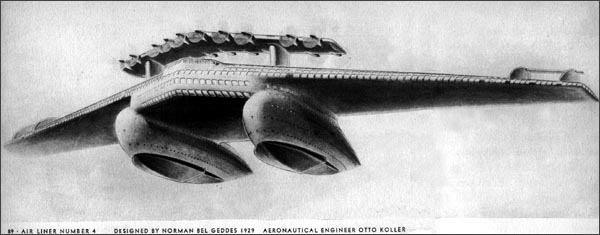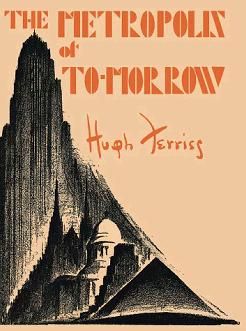Hey folks, Harry here... I'm addicted to articles on SKY CAPTAIN & THE WORLD OF TOMORROW. I read Mr Beaks' article from his set visit, a set visit that was first extended to me, but because Father Geek's birthday was essentially the same day as the invite, and not being here to celebrate with him and my family would be... uncool, I decided to let Mr. Beaks cover it. Besides... I'm so ga-ga in love with this project, it was probably better from a coverage standpoint to let the Beaks man go instead. As a result, I loathe him. I don't understand how he could ever leave Kevin Conran's office/art room. How do you do that?
Well, after reading his article about a dozen times, I decided to see what else had been written online about the flick, so I popped over to CHUD and to my utter delight, it seemed that ol Smilin' Jack Ruby was over there filing multiple reports from the same day, with transcriptions of every word spoken. Set Report One details his description of the footage and everything the Producer said. Set Report Two details his description of the Art Room and transcriptions of Kevin Conran and the visual effects supervisor's descriptions of how they're doing what they're doing.

Personally, I've been reading these over and over, because... well, I'm a geek and it is kinda what we do. Anyway, Smilin Jack recommends taking a look at THE MACHINE AGE IN AMERICA: 1918-1941 if you wish to learn more about the influences on the look of SKY CAPTAIN that Kevin Conran is drawing upon. Kevin listed: Alex Raymond, Raymond Loewy, Norman Bel Geddes and Hugh Ferriss as being the top influences. So let's hit those names and see who they are, ok? That first name, for geeks everywhere... well we know as Mr. Flash Gordon. Alex Raymond was the man! His line work in drawing the world of FLASH GORDON was beautiful. Most of us grew up with Mac Raboy drawing the Flash Gordon we knew, but Alex Raymond invented the visual design that we have fallen in love with. This is the best book for getting to know his work better:

Ok, that next name is Raymond Loewy, and in terms of classic Industrial design, he was a significant god. How much of a god? He invented the Coca-Cola Bottle. Think about that. That original, classic Coca-Cola bottle with those beautiful lines. He designed the Studebaker and the Exxon logos. To discover more of his work check out, INDUSTRIAL DESIGN by Raymond Loewy or NEVER LEAVE WELL ENOUGH ALONE by Raymond Loewy. This quote pretty much sums Loewy up:
"Whether they realized it or not, Americans at mid-century lived in a Loewy-designed world, from the cigarettes they smoked (Lucky Strike's packaging), the soda they drank (the rounded Coca-Cola bottle), the toothpaste they used (Pepsodent's toothpaste tube), the cars they drove (his organization was Studebaker's design and styling department), the buses (Greyhound) and trains (the Pennsylvania Railroad) in which they rode, and the department stores (Gimbel's, Foley's, and Lord & Taylor) and grocery stores (Lucky) where they shopped. "
Next we have Norman Bel Geddes, there's a name that isn't nearly as well known as the previous two. HOWEVER, if you live in Austin, Texas and frequent the Harry Ransom Research Center, as I've been known to do on occassion, then you know all about Geddes. They have archived his work as part of the University of Texas' massive collections. His stunning work for the 1933 Chicago World's Fair and the exhibits he designed for the 1939 New York World's Fair are stunning. From Chrysler to Ringling Bros and Barnum & Bailey... his work was inspired. Norman Bel Geddes wrote only one book called HORIZONS and it is out of print, though there are a couple of copies on Amazon's Marketplace! I read a review of it once saying it was just classic, it apparently shows he even had a wonderful design for a flying car! However, my fave design is his AirShip that was to fly from Chicago to London, like a cruise ship from New York To England. Sigh. If you click on the pic below, you can learn more:

The last name on his list was Hugh Ferriss, and who is that? Well, in 1929, Hugh Ferriss published a book entitled THE METROPOLIS OF TO-MORROW. Ferriss imagined bridges that doubled as gigantic sweeping housing complexes, homes for thousands. He was also one of the designers for the 1939 World's Fair. He worked almost entirely in black and white charcoal and created images that stagger the mind. Oh, to own an original edition... It was reprinted in 1998 though and originals fetch over $700, if you can find them. To see the buildings that were actualized, check out POWER IN BUILDINGS

These illustrators and designers in turn then influenced the film world and the pulp art world surrounding it. When you look at the imagery from SKY CAPTAIN AND THE WORLD OF TOMORROW, there is definitely a pulp feel, but one that is entrenched in the design geniuses of yesteryear that dreamt of a world that looked so much more incredible than one we have ever seen built in ours. Oh... one last influence which Kevin acknowledged was the Fleischer Animated SUPERMAN cartoons that so many of us have loved all our lives!

I'm sorry if this article doesn't offer anything particularly new about the film itself, but I so love the work of the artists mentioned of so briefly by Kevin Conran, that I figured it couldn't hurt to share a little bit about who they were and where you could find out more. This is one of those things I love about film, it can lead you to whole worlds of influences and artwork that you may have otherwise never found. I hope you enjoyed.



